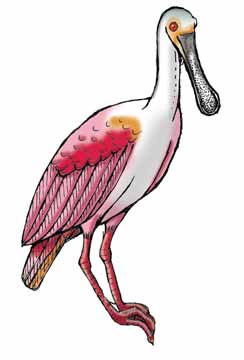

They are found in North America on the east coast from southern Georgia south to Florida and the gulf coast, in Central American, the Caribbean, and South America.
They live in coastal wetlands – marshes, mangrove swamps, estuaries and mud flats.
They can reach over 30 inches (76 cm) tall, yet weigh only about 2.25 pounds. They have long, reddish legs and a long, white neck and back. Their gray bill is long and spoon-shaped. They have a light pink breast and belly and bright crimson wings. They have a bare, greenish head and red eyes. During breeding season, they have a pink feather tuft that comes off the breast. Their pink color comes from the foods they eat, which contain a pigment called canthaxanthin. This pigment also gives the flamingo its pink color.
They spend their time wading through shallow water sweeping their spoon-shaped bill back and forth collecting small animals and grunting as they go. They often feed in large groups wading along in a line. When they fly, they stretch their long necks out before them.
They eat small water animals – like frogs, salamanders, small fish, insects, small crabs and other crustaceans. They feed by wading along in the shallow water (fresh water, coastal marine water and brackish water habitats) and swinging their bill from side to side in the water gathering up their small prey.
Hatchlings can be killed by eagles, raccoons, and turkey vultures.
Females lay up to 5 white eggs with brown spots in large, stick nests built in trees over the water or in mangroves.
They are listed as Least Concern on the IUCN Red List.
Kingdom: Animalia
Phylum: Chordata
Subphylum: Vertebrata
Class: Aves
Order: Ciconiiformes
Family: Threskiornithidae
Subfamily: Plataleinae
Genus: Ajaia
Species: A. ajaja
When you research information you must cite the reference. Citing for websites is different from citing from books, magazines and periodicals. The style of citing shown here is from the MLA Style Citations (Modern Language Association).
When citing a WEBSITE the general format is as follows.
Author Last Name, First Name(s). "Title: Subtitle of Part of Web Page, if appropriate." Title: Subtitle: Section of Page if appropriate. Sponsoring/Publishing Agency, If Given. Additional significant descriptive information. Date of Electronic Publication or other Date, such as Last Updated. Day Month Year of access < URL >.
Amsel, Sheri. "Spoonbill (Roseate) " Exploring Nature Educational Resource ©2005-2024. December 13, 2024
< http://mail.exploringnature.org/db/view/233 >


